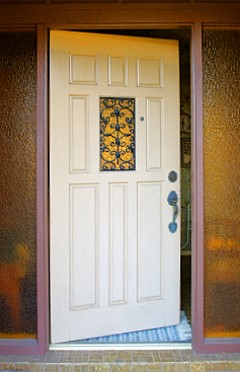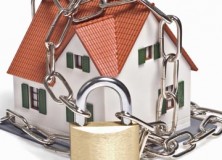 When thinking about how to prevent a home burglary from happening to you there are a few things you should keep in mind. When thieves break into homes, there’s a greater chance of them doing so during the day when many people are at work. Also, around 40 percent of annual household burglaries in the United States are not forced entries, meaning someone was able to walk, climb or crawl inside of houses almost as easily as if the owners left a key in the door [source: Bureau of Justice Statistics].
When thinking about how to prevent a home burglary from happening to you there are a few things you should keep in mind. When thieves break into homes, there’s a greater chance of them doing so during the day when many people are at work. Also, around 40 percent of annual household burglaries in the United States are not forced entries, meaning someone was able to walk, climb or crawl inside of houses almost as easily as if the owners left a key in the door [source: Bureau of Justice Statistics].
To keep unwanted intruders out of your home, you don’t have to turn your property into a suburban Fort Knox. There are many solutions that require little, or no money at all – just a little common sense. Read on to learn 5 tips you can do that take little time or resources to make your home a safer haven.
5. Don’t Brag To Strangers
Leaving certain things lying around your yard or in plain sight from the road can unwittingly lure thieves onto your property like frantic bargain hunters to a flea market. First, if you have a bicycle or scooter that someone could easily walk away with, roll it inside or into your garage. Also, after purchasing a giant new flat screen television or other pricey electronics or appliance, don’t leave the box out beside the trash can or recycling bin [source: Kraeutler]. That tells people you have something brand spanking new that could fetch decent dollars on the street. It may also leave them wondering what other goodies are inside your home. A related tip: If you can’t wait for the recycling truck, to hand them the box from a new purchase, break apart the box and set it out so the printed side can not be seen.
You may also be showing off too much to people walking by your house as well. Open up your curtains, blinds or shades and stroll around the house and see what’s visible. If you have a number of expensive items within plain sight or near windows, think about doing a minor redesign to move them out of view.
4. Fake Them Out
If burglars can tell that someone is home, there’s a greater chance that they won’t attempt to break in. Remember, more break-ins occur during the day when many people are at work. For that reason, when you leave the house, create an illusion that someone’s still there. You can leave a light on, along with music or your television for good measure. Of course, if you’re going to be burning up that electricity by not turning off lights when you leave, make sure you’ve installed compact fluorescent bulbs that last longer and are better for the environment.
You can also mentally fake them out by putting a home security system sign in your yard, or fake cameras mounted on your home. This won’t guarantee they won’t test out whether it’s valid, but it could deter them. Most residential thieves are opportunists who won’t risk testing the security system and stay away from houses with such signs and visible deterrents [source: Sampson].
Security signs and fake cameras
are available on Amazon.com
.
3. Don’t Hide A Key
It may seem like a good idea to leave a spare key hidden under a flower pot or doormat in case you get locked out of your house. But that’s an open invitation for a burglar to walk inside without any difficulty. Someone could also see you retrieve the key at some point, giving away your hiding place.
Instead, give a spare to a neighbor you know well or friend who lives nearby for safekeeping. Since most people now own cell phones, if you lock yourself out you can call for help or walk over to the person’s house. You could also put the spare into a combination lockbox and hide that somewhere outside.
Remember to never put any identifying information on your house keys. If you lose them, and someone else finds them, it would be fairly easy to trace them back to your home and break in.
2. Keep It Looking Occupied
Residential crime spikes during July and August as people set off on summer vacations [source: OIsen]. If you are going out of town for an extended period of time, alert neighbors you trust about your trip and ask that they keep an eye on your property during that time.
More importantly, when you leave town, don’t leave signs of an empty house. That will only make your house look like a giant bulls-eye to a thief. First, if you have a home phone, don’t change your message to alert callers that you have left town. Also avoid having piled up mail, overgrown lawns and newspapers strewn about your yard that send surefire signals you’re miles away.
If you use social media and the Internet, never tweet, or Facebook that you are going away on a vacation. You can brag about your fantastic trip when you return.
Have a friend house sit or at least pick up your newspapers and mail (FYI: The USPS will hold mail delivery for up to 30 days at no charge). Ask them to move your car periodically to make it look like you’re still around. During the winter if you live in a cold weather climate, consider having someone shovel snow from your driveway. In the summers, arrange for someone to cut your lawn.
1. Lock It Up
As mentioned at the beginning, more than 40 percent of break-ins happen without the use of force. That means a lot of people are leaving their houses without locking the doors and windows. If you have a thumb latch lock and a deadbolt on your doors, always lock the dead bolt. Double-check weaker doors such as patio and sliding ones to make sure their locks are strong enough to withstand kicks. When you leave your home, don’t forget to lock up the door leading from the garage to inside. Even if your garage door is down, someone can easily open it.
You may need to change your locks to stronger ones to keep out would-be burglars. Invest in a deadbolt, if your entry doors do not have one.
Disclaimer: On January 4, 2016, the owner of WestEastonPA.com began serving on the West Easton Council following an election. Postings and all content found on this website are the opinions of Matthew A. Dees and may not necessarily represent the opinion of the governing body for The Borough of West Easton.






